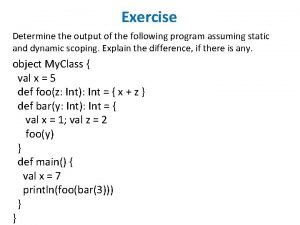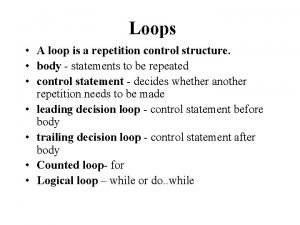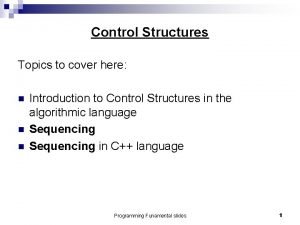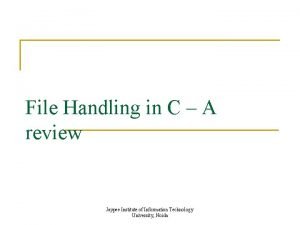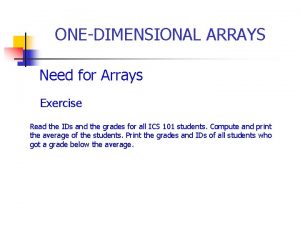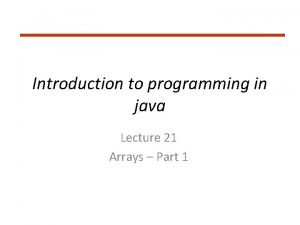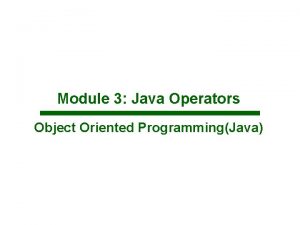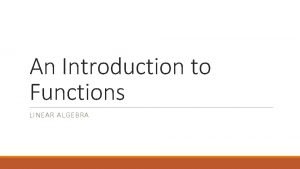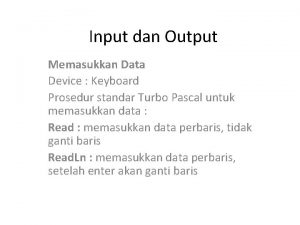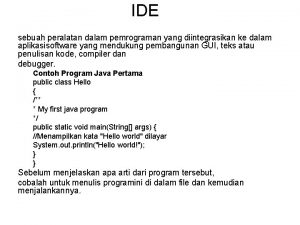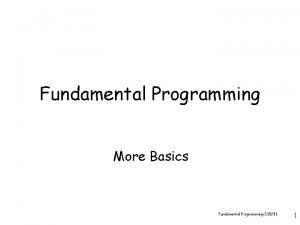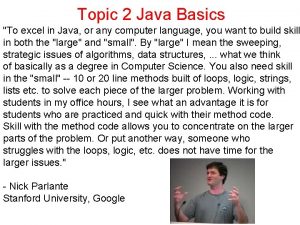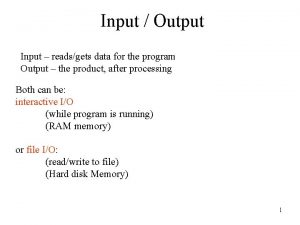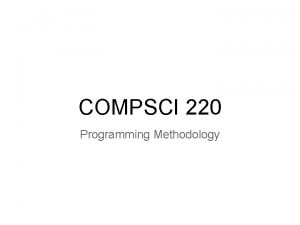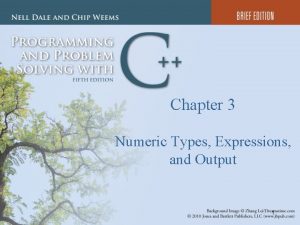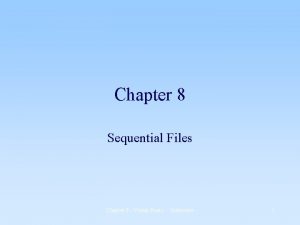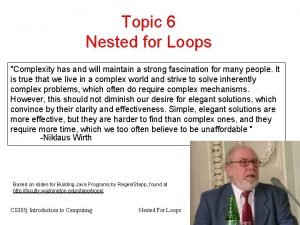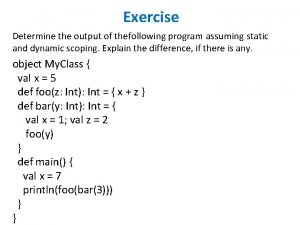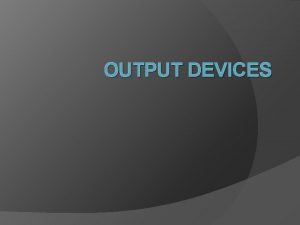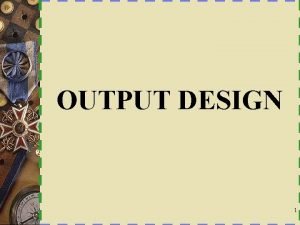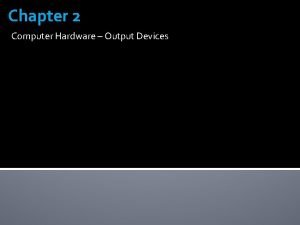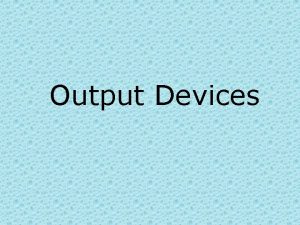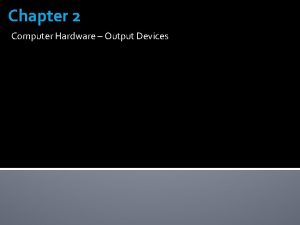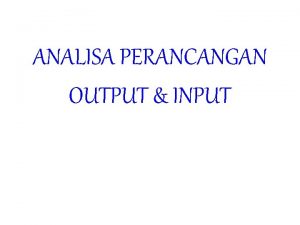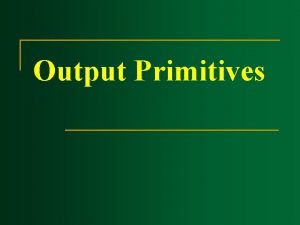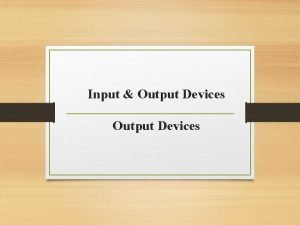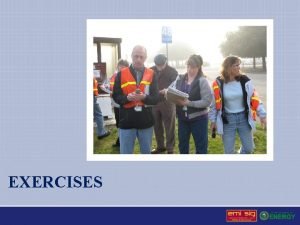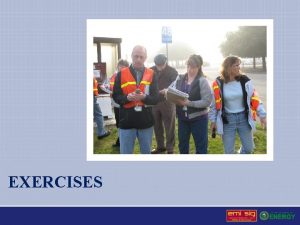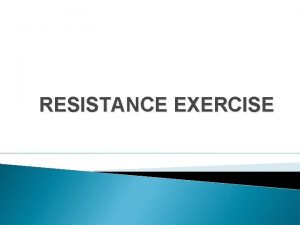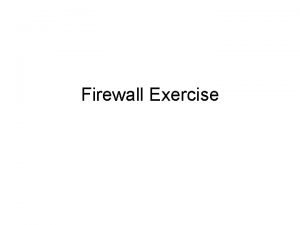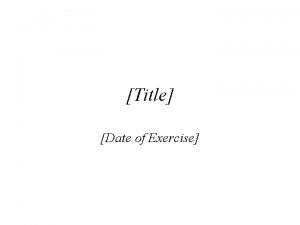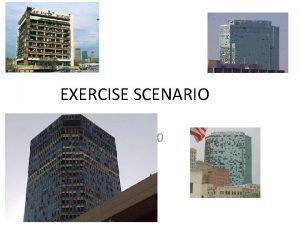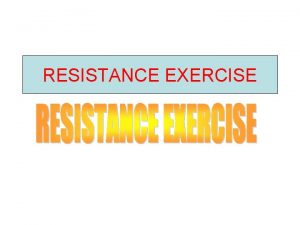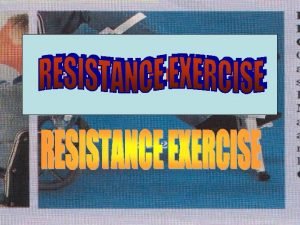Exercise Determine the output of the following program


![Type Checker Implementation Sketch def type. Check( : Map[ID, Type], e : Expr. Tree) Type Checker Implementation Sketch def type. Check( : Map[ID, Type], e : Expr. Tree)](https://slidetodoc.com/presentation_image_h/19996478f82ed81019c2f98ccec356e0/image-3.jpg)













![Example with Arrays def next(a : Array[Int], k : Int) : Int = { Example with Arrays def next(a : Array[Int], k : Int) : Int = {](https://slidetodoc.com/presentation_image_h/19996478f82ed81019c2f98ccec356e0/image-17.jpg)









- Slides: 26

Exercise Determine the output of the following program assuming static and dynamic scoping. Explain the difference, if there is any. object My. Class { val x = 5 def foo(z: Int): Int = { x + z } def bar(y: Int): Int = { val x = 1; val z = 2 foo(y) } def main() { val x = 7 println(foo(bar(3))) } }

type judgement relation if the (free) variables of e have types given by gamma, then e (correctly) type checks and has type T If e 1 type checks in gamma and has type T 1 and. . . and en type checks in gamma and has type Tn then e type checks in gamma and has type T type rule
![Type Checker Implementation Sketch def type Check MapID Type e Expr Tree Type Checker Implementation Sketch def type. Check( : Map[ID, Type], e : Expr. Tree)](https://slidetodoc.com/presentation_image_h/19996478f82ed81019c2f98ccec356e0/image-3.jpg)
Type Checker Implementation Sketch def type. Check( : Map[ID, Type], e : Expr. Tree) : Type. Tree = { e match { case Var(id) => { (id) match case Some(t) => t case None => error(Unknown. Identifier(id, id. pos)) } case If(c, e 1, e 2) => { val tc = type. Check( , c) if (tc != Boolean. Type) error(If. Expects. Boolean. Condition(e. pos)) val t 1 = type. Check( , e 1); val t 2 = type. Check( , e 2) if (t 1 != t 2) error(If. Branches. Should. Have. Same. Type(e. pos)) t 1 } . . . }}

Derivation Using Type Rules x : Int y : Int

Type Rule for Function Application We can treat operators as variables that have function type We can replace many previous rules with application rule: ( )

Computing the Environment of a Class object World { var data : Int var name : String def m(x : Int, y : Int) : Boolean {. . . } def n(x : Int) : Int { if (x > 0) p(x – 1) else 3 } def p(r : Int) : Int = { var k = r + 2 m(k, n(k)) } } Type check each function m, n, p in this global environment

Extending the Environment class World { var data : Int var name : String def m(x : Int, y : Int) : Boolean {. . . } def n(x : Int) : Int { if (x > 0) p(x – 1) else 3 } def p(r : Int) : Int = { var k: Int = r + 2 m(k, n(k)) } }

Type Checking Expression in a Body class World { var data : Int var name : String def m(x : Int, y : Int) : Boolean {. . . } def n(x : Int) : Int { if (x > 0) p(x – 1) else 3 } def p(r : Int) : Int = { var k: Int = r + 2 m(k, n(k)) } }

Remember Function Updates •

Type Rule for Method Bodies Type Rule for Assignments Type Rules for Block: { var x 1: T 1. . . var xn: Tn; s 1; . . . sm; e }

Blocks with Declarations in the Middle just expression empty declaration is first statement is first

Rule for While Statement

Rule for Method Call

Example to Type Check object World { var z : Boolean var u : Int def f(y : Boolean) : Int { z=y if (u > 0) { u=u– 1 var z : Int z = f(!y) + 3 z+z } else { 0 } } } 0 = { (z, Boolean), (u, Int), (f, Boolean Int) } 1 = 0 {(y, Boolean)} Exercise:

Overloading of Operators Int x Int Not a problem for type checking from leaves to root String x String

Arrays Using array as an expression, on the right-hand side Assigning to an array
![Example with Arrays def nexta ArrayInt k Int Int Example with Arrays def next(a : Array[Int], k : Int) : Int = {](https://slidetodoc.com/presentation_image_h/19996478f82ed81019c2f98ccec356e0/image-17.jpg)
Example with Arrays def next(a : Array[Int], k : Int) : Int = { a[k] = a[a[k]] } Given = {(a, Array(Int)), (k, Int)}, check |- a[k] = a[a[k]]: Int

Type Rules (1) variable constant function application plus if while assignment

Type Rules (2) block array use array assignment

Type Rules (3) c - top-level environment of class C { var x: Int; def m(p: Int): Boolean = {…} } c = { (x, Int), (m, C x Int Boolean)} method invocation field use field assignment

Does this program type check? class Rectangle { var width: Int var height: Int var x. Pos: Int var y. Pos: Int def area(): Int = { if (width > 0 && height > 0) width * height else 0 } def resize(max. Size: Int) { while (area > max. Size) { width = width / 2 height = height / 2 } } }

Meaning of Types • Types can be viewed as named entities – explicitly declared classes, traits – their meaning is given by methods they have – constructs such as inheritance establish relationships between classes • Types can be viewed as sets of values – Int = {. . . , -2, -1, 0, 1, 2, . . . } – Boolean = { false, true } – Int = { f : Int -> Int | f is computable }

Types as Sets • Sets so far were disjoint String “Richard” “cat” Boolean true, false • Sets can overlap C represents not only declared C, but all possible extensions as well Pos (1 2) Int 16 bit C class C Neg (-1) class D Int Int Pos class F class E D E F F extends D, D extends C

SUBTYPING

Subtyping • Subtyping corresponds to subset • Systems with subtyping have non-disjoint sets • T 1 <: T 2 means T 1 is a subtype of T 2 – corresponds to T 1 T 2 in sets of values • Rule for subtyping: analogous to set reasoning

Types for Positive and Negative Ints Int = {. . . , -2, -1, 0, 1, 2, . . . } Pos = { 1, 2, . . . } (not including zero) Neg = {. . . , -2, -1 } (not including zero) Pos <: Int Neg <: Int Pos Int Neg Int (y not zero) (x/y well defined)
 Find the output of the following program
Find the output of the following program Nest loop
Nest loop Find the output of the following program
Find the output of the following program What will be the output of following program?
What will be the output of following program? What is the output of the following program:
What is the output of the following program: What is the output of the following program:
What is the output of the following program: Determine the output class opbitwise
Determine the output class opbitwise Determine whether the following relation is a function.
Determine whether the following relation is a function. Personal exercise program
Personal exercise program Homeland security exercise and evaluation program
Homeland security exercise and evaluation program Exercise answer the following questions
Exercise answer the following questions Output dari program
Output dari program Output dari program
Output dari program Program output
Program output Output of java program
Output of java program Program output
Program output Program output
Program output How to use set precision
How to use set precision Output of the following code
Output of the following code Complexity of 3 nested for loops
Complexity of 3 nested for loops Hình ảnh bộ gõ cơ thể búng tay
Hình ảnh bộ gõ cơ thể búng tay Ng-html
Ng-html Bổ thể
Bổ thể Tỉ lệ cơ thể trẻ em
Tỉ lệ cơ thể trẻ em Chó sói
Chó sói Tư thế worm breton
Tư thế worm breton Alleluia hat len nguoi oi
Alleluia hat len nguoi oi
